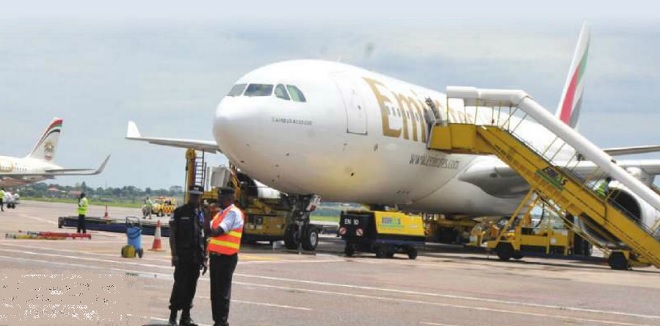
National carrier revival question: World Bank calls for more focus on high cost of doing business instead
At the beginning of his fifth term in office, President Yoweri Museveni set tongues wagging when he included the revival of the national career among his 20 priority programmes in this term of office. It was President Museveni’s government that liquidated the national airline – Uganda Airlines – 15 years ago as part of the privatisation strategy aimed at reducing government expenditure on loss-making state-owned enterprises.
The airline was established in 1976 by former President Idi Amin and boasted of a fleet of least 15 aircraft, which flew to destinations within Africa and Europe plus Asia.
At the Oct.09 Independence Day celebrations, President Yoweri Museveni reiterated the same stand saying the national career would be in the air in the near future, suggesting that the conditions for a profit-making airline are now in place and reviving the national carrier is one of the strategies that would drive the country to middle income status by 2020.
“We allowed Uganda Airlines to die because it was making losses and, at that time, Ugandans were not travelling as much as today,” President Museveni said.
“Somebody has told me that Ugandans are spending $420 million per year on travel. Therefore, the NRM Government has decided to start a national airline to stop the outflow of this money and to end travel inconveniences to Ugandans.”
While most of the 20 “priority” programmes are generally agreeable, it’s the revival of the national career that has generated the most debate. Not to be outdone, the World Bank has also joined the fray.
Rachel Sebudde, the World Bank’s senior economist in Uganda, says the government needs to be strategic in each of the infrastructure projects it undertakes with the aim of reducing the high cost of doing business or at least solving a social welfare problem.
In an exclusive interview, Sebudde told The Independent that basing on those parameters visa vie the list of infrastructure projects that the government has on the table, some of them could be have big question marks.
“For example, if we say that we need to have a national airline, is that really the best way to reduce the cost of doing business in Uganda or there’s an alternative?” She said.
“I believe there are already other airlines that are operating in Uganda, some of them by Ugandans and are already offering that service. So, do you really need a state-owned airline to achieve that? Probably not.”
She said there’s need for the government to carry out an assessment of whether using a national airline would be cheaper for business as compared with the other airlines prior to making any decision to revive the national carrier.
However, some see the Uganda Airlines revival as just mere talk given that it’s not the first time that the government is trying to revive the national carrier. Other analysts also share Sebudde’s concerns.
In the 1990’s, the government attempted to revive the airline in partnership with Tanzania as a joint venture code-named Alliance Air.
Later, South African Airways was invited on board with the assumption that both Uganda and Tanzania domestic services would feed into SAA long-haul capacity. The initiative did not yield any fruits.
Indeed, the purported plans to revive the national carrier come at a time when airlines around the globe, especially those that are state-owned in Africa, are struggling to remain in air amid stiff competition from global players.
According to the latest International Air Transport Association (IATA) report released last June, African airlines are expected to post a $500 million loss in 2016, a slight improvement on the $700 million that the region’s carriers registered in 2015 as capacity growth estimated at 5.3% is anticipated to outpace demand growth of 4.5%.
“Carriers in the region continue to confront a plethora of challenges including intense competition on long-haul routes, political barriers to growing intra-Africa traffic, high costs and infrastructure deficiencies,” the report reads in part.
“In addition, many major economies in the continent have been hit hard by the collapse of commodity prices, and the impact that has had on revenues and the inflow of hard currencies. Unresolved foreign exchange crises are adding to the economic difficulties facing airlines in this region.”
For instance, Africa’s low-cost carrier Fastjet has warned that losses will continue well into the near future after a “prolonged downturn” in its home market. The Tanzania-based carrier, which flies to, Kenya, Uganda, Malawi, Zimbabwe, and South Africa, clocked up a $30.5 million loss in the year to December 31, 2015, which it blamed on lower spending and political turmoil across Africa as well as currency devaluations.
 The Independent Uganda: You get the Truth we Pay the Price
The Independent Uganda: You get the Truth we Pay the Price


